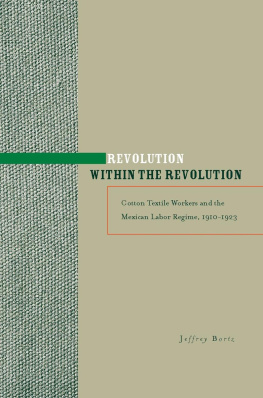Hiring the Black Worker
1999 The University of North Carolina Press
All rights reserved
Designed by April Leidig-Higgins
Set in Minion by Running Feet Books
Manufactured in the United States of America
The paper in this book meets the guidelines for permanence and durability of the Committee on Production Guidelines for Book Longevity of the Council on Library Resources.
Library of Congress Cataloging-in-Publication Data
Minchin, Timothy J. Hiring the black worker: the
racial integration of the Southern textile industry,
19601980 / by Timothy J. Minchin.
p. cm. Includes bibliographical references and index.
ISBN 0-8078-2470-4 (cloth : alk. paper)
ISBN 0-8078-4771-2 (pbk.: alk. paper)
1. Discrimination in employmentsSouthern States
History20th century. 2. Textile workersSouthern
StatesHistory20th century. 3. Race discrimination
Southern StatesHistory20th century. 4. Trade
unionsAfro-American membershipSouthern States
History20th century. I. Title.
HD4903.3.T42U66 1999 331.6396073dc21
98-30146 CIP
Portions of chapters 4 and 8 previously appeared in
Timothy J. Minchin, Color Means Something: Black
Pioneers, White Resistance, and Interracial Unionism
in the Southern Textile Industry, 19571980, Labor
History 39, no. 2 (May 1998): 10933. Used by
permission.
03 02 01 00 99 5 4 3 2 1
THIS BOOK WAS DIGITALLY PRINTED.
Contents
one
There Were No Blacks Running the Machines: Black Employment in the Southern Textile Industry before 1964
two
The Government Brought About the Real Change: Causes of the Racial Integration of the Southern Textile Industry, 19641980
three
For Quite Obvious Reasons, We Do Not Want to Fill These Mills Up with Negroes: The Attitudes of Textile Executives to Black Employment
four
I Felt Myself as a Pioneer: The Experiences of the First Black Production Workers
five
The Only Ones That Got a Promotion Was a White Man: The Discriminatory Treatment of Black Men in the Textile Industry, 19641980
six
Getting Out of the White Mans Kitchen: African American Women and the Racial Integration of the Southern Textile Industry
seven
Community Activism and Litigation: The Role of Civil Rights Organizations in the Racial Integration of the Southern Textile Industry
eight
A Mixed Blessing: The Role of Labor Unions in the Racial Integration of the Southern Textile Industry
Illustrations
Black worker feeding cotton
Quiller technician, 1968
Production worker in the carpet and rug industry
Black man in card room
Black woman in sewing operation
Black woman spinner, 1968
Laura Ann Pope, 1973
Tables
1. Number of Shift Foremen, Total and Black, at Dan River Mills, 19651973
2. Comparison of Black and White Hiring Rates at J. P. Stevens, 19691980
3. Racial Disparities in Pay Rates among All Male Employees at J. P. Stevens, 19671972
4. Average Pay Rates of Hourly Male Employees at Dan River Mills, Danville Division, April 1969
5. Average Pay Rates of Hourly Males Employees at Dan River Mills, Danville Division, April 1973
6. Proportion of Male Employees at the Bottom and Top of the Pay Scale at Dan River Mills, April 1969
7. Proportion of Male Employees at the Bottom and Top of the Pay Scale at Dan River Mills, April 1973
8. Average Pay Rates of Male Employees in Racially Identifiable Jobs at Dan River Mills, January 31, 1972
9. Average Pay Rates of Hourly Male Employees by Race and Year of Hire at Dan River Mills, January 31, 1972
10. Comparison of Pay Rates of Hourly and Incentive Male Employees by Race and Education Level at J. P. Stevens Plants in Roanoke Rapids, N.C., December 28, 1980
11. Comparison of Pay Rates of Black and White Male Hourly Employees at J. P. Stevens, 19661974
12. Racial Composition of Job Classifications in Cone Mills Power Plant, December 15, 1971
13. Racial Hiring Rates at J. P. Stevens, Mid-May 1969-June 30, 1972
14. Black Female Textile Workers Compared to White Female Textile Workers in South Carolina Piedmont Counties, 1967
15. Comparison of the Percentage of White Applicants and Black Applicants Who Were Hired at J. P. Stevens, 19691975
16. Assignment of New Hires to the Weaver Job by Race and Sex at Dan River Mills, January 1, 1969-March 31, 1971
17. Comparison of Turnover by Race and Sex at Dan River Mills, Danville Division, 1969
18. Racial Composition of South Carolina Piedmont Counties Covered by TEAM, 1960
19. Textile Employment Compared to Total Manufacturing Employment in South Carolina Piedmont Counties, 1967
20. Black Textile Workers Compared to Total Textile Workers in South Carolina Piedmont Counties, 1967
Acknowledgments
This book was researched and written while I was Mellon Research Fellow at Cambridge University. I wish to acknowledge the financial assistance of the Mellon Fund that allowed me to undertake several extended research trips to the United States. I also wish to acknowledge the support provided by Sidney Sussex College in Cambridge, where I was a fellow between 1995 and 1998. The college provided a wonderful research environment that helped a great deal in the writing of this book. I would also like to thank St. Andrews University for allowing me time to add the finishing touches to this book before I started my teaching duties with them.
I owe a great debt to my friend and colleague, Jim Leloudis. Jim helped arrange for me to be a visiting scholar at the University of North Carolina in 1996, and he was supportive and helpful throughout. I am also grateful to other members of the Leloudis family, of a wide variety of ages, who looked after and entertained me while I was in the United States. Especially I thank Dianne, James, and Virginia for their hospitality and friendship. Other friends in the United States helped me in many ways. I especially wish to express my thanks to my friends Rick and Hatsy Nittoli, George Waldrep, and Richard and Claire Zieger, who all helped me a great deal while I was living in North Carolina. Many people were kind enough to put me up while I was on my travels, and in this regard I especially wish to thank Norris and Alice Tibbetts, Laura Ann Pope, and Bob and Gay Zieger.
Various members of the Union of Needletrades, Industrial, and Textile Employees (UNITE!) helped me in setting up and carrying out interviews. On many occasions, UNITE! members allowed me to use their union halls for interviews, and I thank them for this. I owe a special thanks to UNITE! joint board managers who helped me locate many of the people I needed to see, especially Reese Boulware in Columbus, Georgia; Sammy Glover in Andalusia, Alabama; James Johnson in Andrews, South Carolina; Clyde Bush in Roanoke Rapids, North Carolina, and Sydney Young in Rock Hill, South Carolina. UNITE! organizer Nick Atkins assisted me in carrying out interviews in the Columbus, Georgia, area. Former organizer Bob Freeman was a great help with interviews in Kannapolis, North Carolina. UNITE!s southern regional director, Bruce Raynor, also helped me a great deal when I was carrying out my interviews across the South. In Andrews, South Carolina, Laura Ann Pope was of enormous assistance. I wish to thank all those whom I interviewed for providing me with such an enjoyable and memorable experience, and especially for being so hospitable and helpful.





